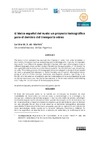Identificador persistente para citar o vincular este elemento:
https://accedacris.ulpgc.es/handle/10553/70380
| Campo DC | Valor | idioma |
|---|---|---|
| dc.contributor.author | de- Matteis, Lorena Marta Amalia | en_US |
| dc.date.accessioned | 2020-02-19T18:02:40Z | - |
| dc.date.available | 2020-02-19T18:02:40Z | - |
| dc.date.issued | 2017 | en_US |
| dc.identifier.issn | 1133-1127 | en_US |
| dc.identifier.uri | https://accedacris.ulpgc.es/handle/10553/70380 | - |
| dc.description.abstract | El léxico del transporte aéreo se ha nutrido con el trasvase de términos de otras modalidades de locomoción, de ciencias como la meteorología o la ornitología y ha incorporado préstamos de distintas lenguas. Si bien ha sido objeto de estudio lexicológico en distintas lenguas, existen escasos estudios que aborden la apropiación de este léxico por los no especialistas y ningún diccionario de español que dé cuenta de los usos no técnicos de tales unidades léxicas. Este artículo presenta las decisiones lexicográficas adoptadas para diseñar El léxico español del vuelo, propuesta que intenta registrar el uso cotidiano de voces aeronáuticas, dando cuenta de su variación diatópica, diacrónica y diafásica. En términos específicos, se describe tanto la selección de materiales y la conformación de la base de datos léxica como la macroestructura del texto, los criterios que operaron en la selección y ordenamiento de los lemas y, por último, la microestructura de los artículos del diccionario. | en_US |
| dc.description.abstract | The lexicon of air transport has received the influence of terms from other modalities of locomotion, of sciences such as meteorology and ornithology and it has also incorporated loan words from different languages. Although it has been the object of lexicological study in different languages, there are few studies that address the appropriation of this lexicon by non-specialists and no dictionary exists that accounts for the non-technical uses of such lexical units. This article presents the lexicographic decisions adopted to design El léxico español del vuelo, a proposal that attempts to record the daily use of Spanish aeronautical words, giving an account of their diatopic, diachronic and diaphasic variation. Specifically, it describes both the selection of materials and the conformation of the lexical database as well as the text macrostructure, the criteria that operated in the lemmas selection and ordering and, finally, the microstructure of the lexicographic articles. | en_US |
| dc.language | spa | en_US |
| dc.relation.ispartof | LFE. Revista de Lenguas para Fines Específicos | en_US |
| dc.source | LFE. Revista de lenguas para fines específicos [eISSN 2340-8561], v. 23 (2), p. 290-312 | en_US |
| dc.subject | 570107 Lengua y literatura | en_US |
| dc.subject | 550510 Filología | en_US |
| dc.subject.other | Lexicografía | en_US |
| dc.subject.other | Léxicos especializados | en_US |
| dc.subject.other | Habla cotidiana | en_US |
| dc.subject.other | Español | en_US |
| dc.subject.other | Lexicography | en_US |
| dc.subject.other | Specialized lexicons | en_US |
| dc.subject.other | Daily speech | en_US |
| dc.subject.other | Spanish | en_US |
| dc.title | El léxico español del vuelo: un proyecto lexicográfico para el dominio del transporte aéreo | en_US |
| dc.type | info:eu-repo/semantics/article | en_US |
| dc.type | Article | en_US |
| dc.identifier.doi | 10.20420/rlfe.2017.183 | en_US |
| dc.investigacion | Artes y Humanidades | en_US |
| dc.type2 | Artículo | en_US |
| dc.identifier.ulpgc | Sí | es |
| dc.description.esci | ESCI | |
| dc.description.dialnetimpact | 0,0 | |
| dc.description.dialnetq | Q3 | |
| dc.description.dialnetd | D6 | |
| dc.description.erihplus | ERIH PLUS | |
| item.grantfulltext | open | - |
| item.fulltext | Con texto completo | - |
| Colección: | Artículos | |
Visitas
81
actualizado el 04-may-2024
Descargas
95
actualizado el 04-may-2024
Google ScholarTM
Verifica
Altmetric
Comparte
Exporta metadatos
Los elementos en ULPGC accedaCRIS están protegidos por derechos de autor con todos los derechos reservados, a menos que se indique lo contrario.
